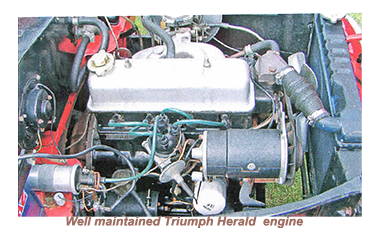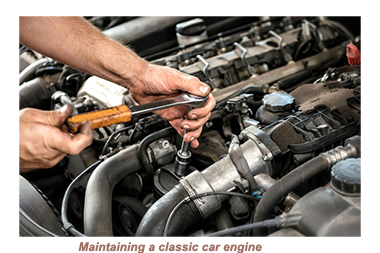
 In most cases, the focal point of every classic car restoration project was its engine. Vehicles produced during the Fifties and Sixties were exclusively powered by a conventional internal combustion engine.
In most cases, the focal point of every classic car restoration project was its engine. Vehicles produced during the Fifties and Sixties were exclusively powered by a conventional internal combustion engine.

In most cases, the focal point of every classic car restoration project was its engine. Vehicles produced during the Fifties and Sixties were exclusively powered by a conventional internal combustion engine.
Of the pieces that go to make up a classic car restoration jigsaw, the engine restoration can often be the most challenging and expensive. Depending on how the engine has been stored after it has been taken of the road, its way back to being once again driveable.
Although once the engine rebuild has been successfully completed it should reasonably be expected to provide many years of enjoyable and problem free motoring pleasure for as well as a source of considerable pride.
Whether the restored classic is to be used exclusively for display, very occasionally driven to owner’s meetings and car shows or even used as a daily driver, it is the responsibility of the owner to make sure that the engine is being carefully maintained and functioning to its maximum.
 In its first phase of life, the typical lifespan of a classic car engine was around eight years or 150,000 miles. In recent years, advancements in technology, service standards, and design have led to an increase in the average life expectancy of vehicles. Currently, the average life expectancy of a new or fully recondition engine could be as high as 200,000 miles or approximately 10 years, if properly looked after.
In its first phase of life, the typical lifespan of a classic car engine was around eight years or 150,000 miles. In recent years, advancements in technology, service standards, and design have led to an increase in the average life expectancy of vehicles. Currently, the average life expectancy of a new or fully recondition engine could be as high as 200,000 miles or approximately 10 years, if properly looked after.
The internal combustion engine is responsible for generating power to move a vehicle by combining fuel, air, pressure, and electricity to create controlled explosions that move the car's pistons up and down.
T
TThe combustion chamber is a crucial component of an internal combustion engine, consisting of the cylinder, piston, and cylinder head.
In an internal combustion engine, the combustion chamber is comprised of three main components: the cylinder, the piston, and the cylinder head.
Specifically, the cylinder functions as the wall of the combustion chamber, while the top of the piston serves as the floor. Finally, the cylinder head is responsible for acting as the ceiling of the combustion chamber.
![]()
![]() The first step in an engine maintenance procedure is always to start the engine and listen for any unusual noises. A well-functioning engine should run smoothly without any knocking, tapping, or rattling sounds.
The first step in an engine maintenance procedure is always to start the engine and listen for any unusual noises. A well-functioning engine should run smoothly without any knocking, tapping, or rattling sounds.
![]() Look for any signs of smoke coming from the engine or exhaust. Smoke could indicate a problem with the fuel system, oil system, or engine components.
Look for any signs of smoke coming from the engine or exhaust. Smoke could indicate a problem with the fuel system, oil system, or engine components.

![]() Monitor engine performance while the car is being driven. Ensure that the engine accelerates smoothly, idles properly, and does not hesitate or stall.
Monitor engine performance while the car is being driven. Ensure that the engine accelerates smoothly, idles properly, and does not hesitate or stall.
![]() Check the oil level and quality. Ensure that the oil level is within the recommended range and that it is clean and free of debris.
Check the oil level and quality. Ensure that the oil level is within the recommended range and that it is clean and free of debris.
![]() Check the coolant level and quality. Ensure that the coolant level is within the recommended range and is clean and free of foreign bodies.
Check the coolant level and quality. Ensure that the coolant level is within the recommended range and is clean and free of foreign bodies.
![]() Inspect the engine for any signs of leaks, corrosion, or damage. Look for any cracks, warping, or excessive wear in the engine components.
Inspect the engine for any signs of leaks, corrosion, or damage. Look for any cracks, warping, or excessive wear in the engine components.
![]() Perform a compression test on the engine to ensure the proper amount of compression is generated. Low compression can indicate a problem with the engine or other components.
Perform a compression test on the engine to ensure the proper amount of compression is generated. Low compression can indicate a problem with the engine or other components.
![]() Changing the oil at regular intervals is crucial to maintaining the health of the engine. Follow the manufacturer's recommendations for the type of oil and the interval for changing it.
Changing the oil at regular intervals is crucial to maintaining the health of the engine. Follow the manufacturer's recommendations for the type of oil and the interval for changing it.

![]() Regularly clean the engine to prevent debris and dirt from accumulating. Use a degreaser to clean the engine components and avoid using high-pressure water that can damage electrical components.
Regularly clean the engine to prevent debris and dirt from accumulating. Use a degreaser to clean the engine components and avoid using high-pressure water that can damage electrical components.
![]() Replacing the air filter at regular intervals ensures that the engine is receiving a steady supply of clean air.
Replacing the air filter at regular intervals ensures that the engine is receiving a steady supply of clean air.
![]() Inspect the belts and hoses for any signs of wear or damage. Replace them if they are worn or damaged.
Inspect the belts and hoses for any signs of wear or damage. Replace them if they are worn or damaged.
 Driving the car regularly helps keep the engine and related components in good working condition. Being turned over on a regular basis will also prevents the build-up of moisture in the engine.
Driving the car regularly helps keep the engine and related components in good working condition. Being turned over on a regular basis will also prevents the build-up of moisture in the engine.
By following these steps rigourously, the health of a classic car engine will be maintained, ensuring that it will continue to function at a high level for many years to come.




